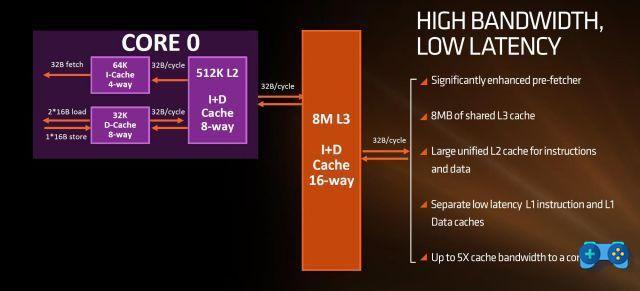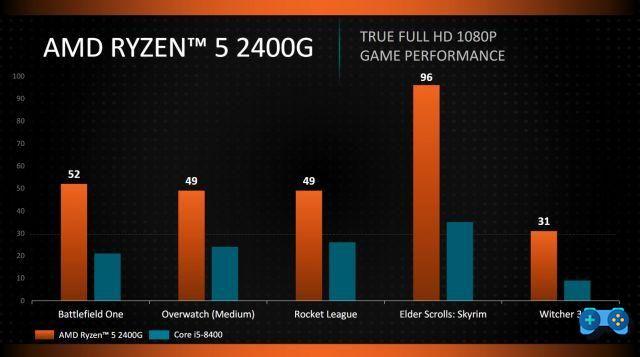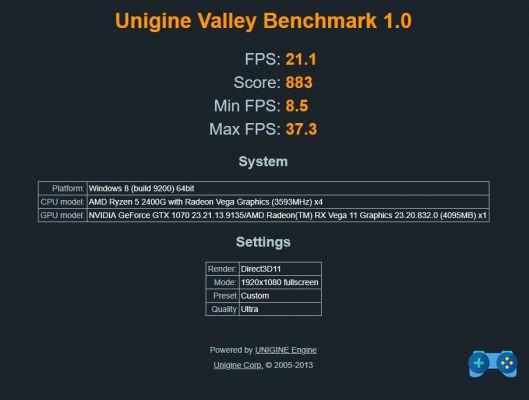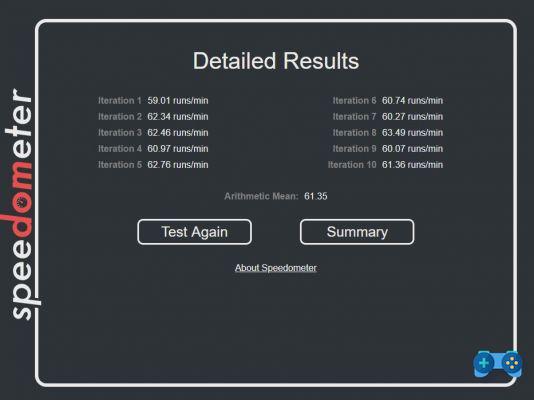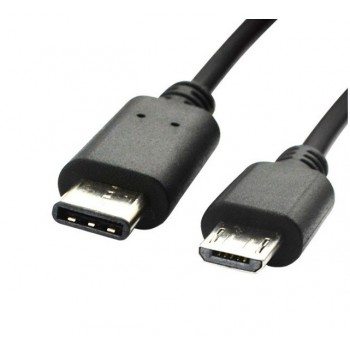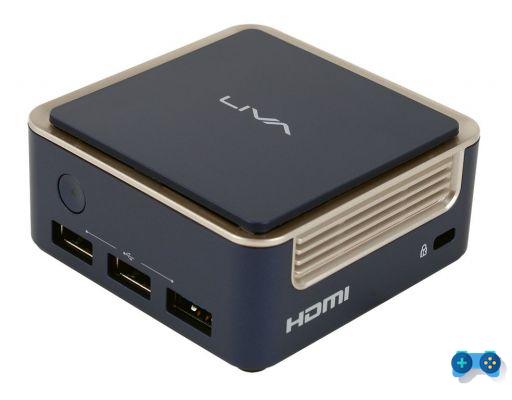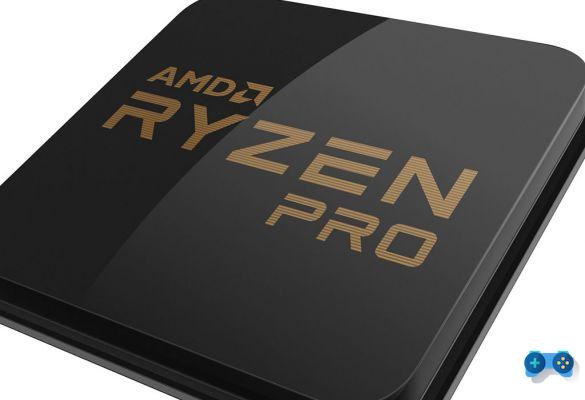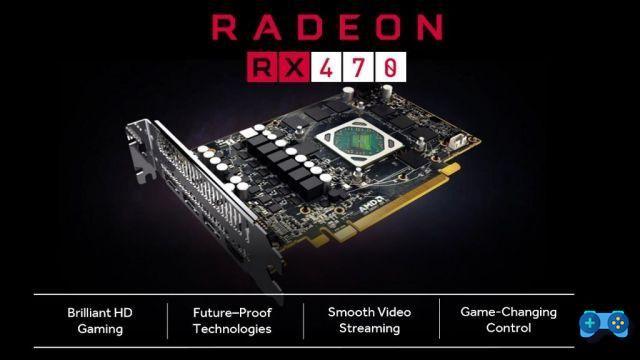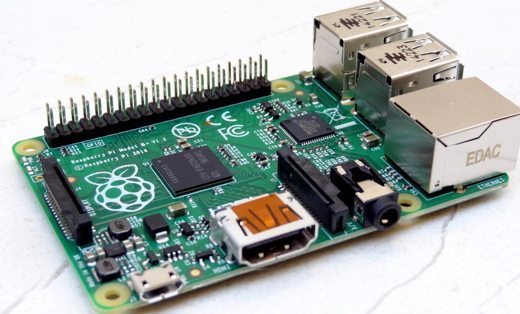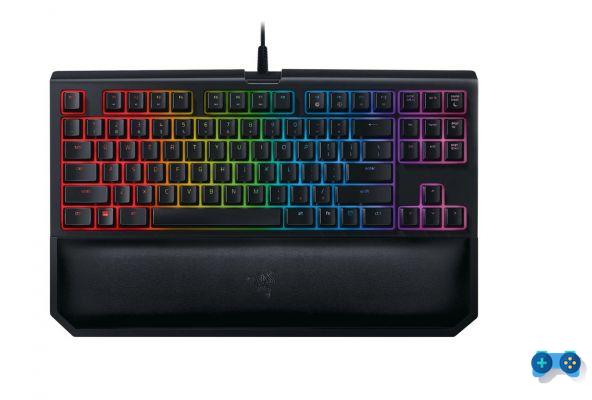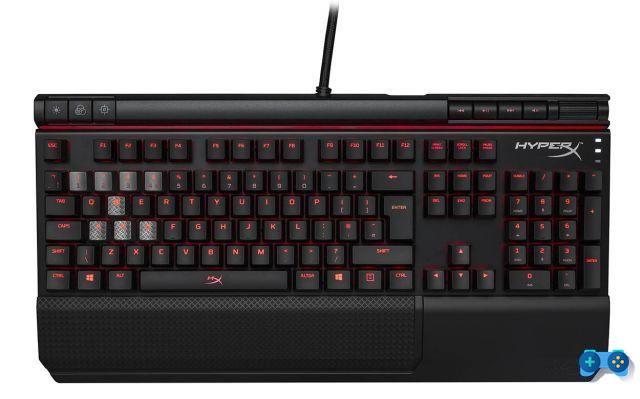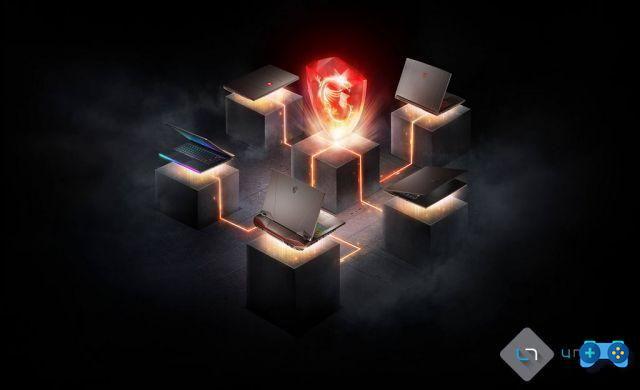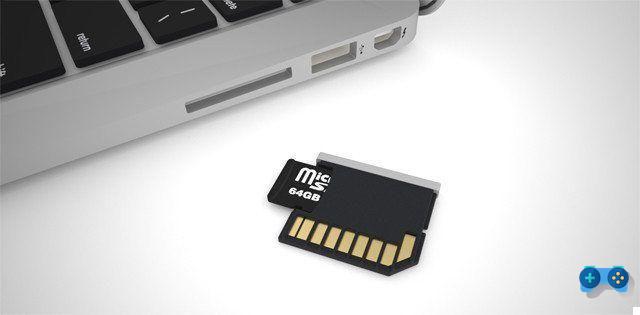
The ultimate processor for an entry level build and work in progress.
It is certainly not a good time to enter the world of PC gaming or to renew your Master Race gear. The reason is to be found in a series of reasons including: RAM memories at prices that are still too high and graphics cards practically unavailable at decent prices (with exceptions such as in these cases EVGA GTX 1060 at 265 euros and Sapphire Radeon RX 580 at 249 euros ), partly due to the lack of memories, cannibalized by modern smartphones and partly due to the mining phenomenon, which, despite the decline in cryptocurrencies in recent months, continues to almost totally absorb the narrow production.
However, something is already changing mainly because there are the new NVIDIA and AMD graphics cards, which according to some will try to limit the mining phenomenon and, above all, because AMD has finally unveiled its units with Integrated Vega GPU, which will certainly represent a good starting point for low budget gaming configurations (gaming, you read that right) in the market range around 500 euros, all included (no monitor), waiting for more funds to be dedicated to the dedicated graphics card, once the market has stabilized.
APU or CPU?
The difference between a processor and an APU (Accelerated Processing Unit) is quite simple: while a normal processor is unable to process images and send them to the monitor, the APUs have an integrated graphics card (in the die processor) able at least normally to provide the bare minimum in terms of graphics power, for turning on the PC and for using the office suites and viewing videos in high definition.
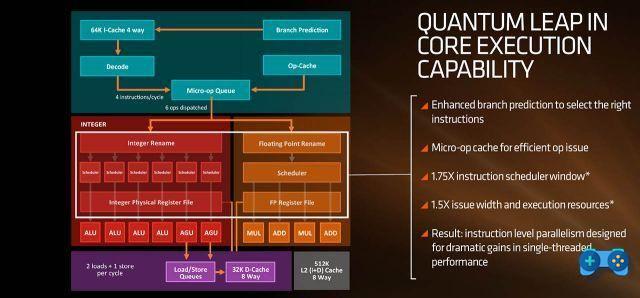
The idea of a processor that could also provide basic graphics processing functions came from AMD and its acquisition of ATI. The result of the know-how of the graphics card manufacturer, however, comes only much later, in 2011, with the launch of the first E350 APUs (Zacate and Ontario chips). The Llano series followed first and then Kaveri. However, just Kaveri represents the watershed for the APUs of the manufacturer AMD: after this chipset, in fact, AMD abandoned the approach of a separate CPU and GPU on the ASIC die, adopting instead a hybrid technology just like that of Raven Ridge and the new Ryzen. With it, CPU and GPU act as co-processors sharing the same information for the benefit of energy efficiency and performance.
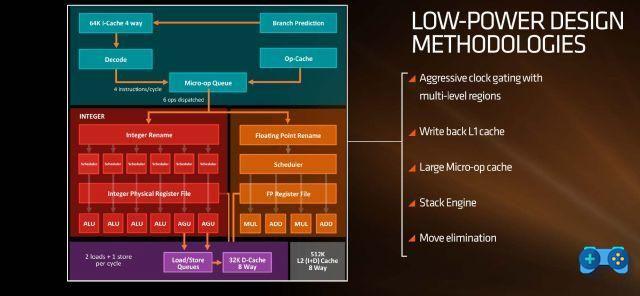 The announcement of the new APUs based on Vega architecture, that is Ryzen 3 2200G e Ryzen 5 2400G, which took place in February, was immediately followed by the first availability for newspapers, including ours, which was given the opportunity to try the more performing of the two APUs, the Ryzen 5 2400G.
The announcement of the new APUs based on Vega architecture, that is Ryzen 3 2200G e Ryzen 5 2400G, which took place in February, was immediately followed by the first availability for newspapers, including ours, which was given the opportunity to try the more performing of the two APUs, the Ryzen 5 2400G.
Differences
The first and most interesting feature is the compatibility of new APUs with B350 and X370 motherboards with a small firmware update, allowing you to access a wide choice of motherboards with very competitive prices. A very different behavior compared to that adopted by Intel, with its Coffee Lake, which forced many early adopters to choose a new motherboard despite the processors using the same socket.
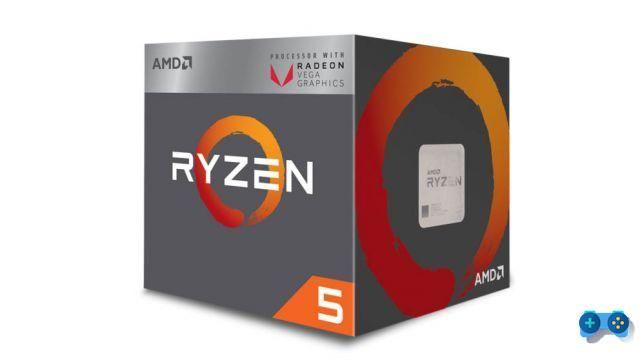 The new AMD models support dual-channel DDR4-2933 memory by default and differ mainly in the integrated graphics card: AMD Ryzen 3 2200G indeed features a Radeon 8 Vega, while AMD Ryzen 5 2400G is equipped with a Radeon 11 Vega. The number is not random and identifies the number of clusters present on each Vega GPU. By multiplying the number of shaders present on each cluster (64) we can begin to get an idea of the differences between the two graphics processors. While the 2200G has a GPU with 512 shader processors, the 2400G comes with 704 shader processors. What does this mean in terms of graphics power? We will reveal it to you and you will surely understand it from our graphs below, but we can already tell you that what Intel proposed with its Coffee Lake is not even remotely comparable to what AMD expected.
The new AMD models support dual-channel DDR4-2933 memory by default and differ mainly in the integrated graphics card: AMD Ryzen 3 2200G indeed features a Radeon 8 Vega, while AMD Ryzen 5 2400G is equipped with a Radeon 11 Vega. The number is not random and identifies the number of clusters present on each Vega GPU. By multiplying the number of shaders present on each cluster (64) we can begin to get an idea of the differences between the two graphics processors. While the 2200G has a GPU with 512 shader processors, the 2400G comes with 704 shader processors. What does this mean in terms of graphics power? We will reveal it to you and you will surely understand it from our graphs below, but we can already tell you that what Intel proposed with its Coffee Lake is not even remotely comparable to what AMD expected.
The APUs are developed under the codename Raven Ridge and are equipped with approximately 4,94 billion transistors. They are both quad-core processors, but technically Ryzen 5 can boast more threads, 8, and SMT. Radeon 2200G, on the other hand, only has 4 cores enabled and does not support SMT.
The Ryzen 3 2200G and Ryzen 5 2400G will be configured as a single CCX configuration (4 + 0), while a “normal” Ryzen 5 1400 processor has a CCX 2 + 2 configuration.
Clock rates also grow compared to the previous Ryzen 3 and 5, which now go up to 3.5 GHz with a boost of up to 3.7 GHz, for Ryzen 2200G, and 3.6 GHz up to 3.9 GHz, for Ryzen 2400G, with a stock GPU frequency. at 1250 MHz; in addition, the TDP up to 65W for both processors thanks to the 14nm manufacturing process. Then the cache architecture and the number of lanes available change: in the first case, the L3 cache of the new Raven ridge goes to 4 MB against the 8 MB of Ryzen processors without APU, while the L2 remains identical, 512K per core, while the PCIe lanes go from 16 to 8 in the Raven Ridge design. Wanting to make a comparison from a technical point of view, the 2400G object of this test corresponds to the Ryzen 1400, but with the addition of an integrated APU at the same price and higher clock that is close to that of the Ryzen 7. Even if you will no longer use the GPU, in short, the 2400G remains an overall much better choice than the Ryzen 1400 from all points of view.
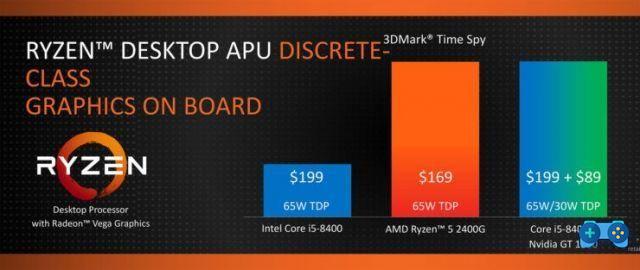 "Old and new" technologies
"Old and new" technologies
The new Ryzen G processor series inherits some technologies from the previous one. Everything is based as always on the technological process Infinity Fabric, which we talked about extensively HERE, and which essentially represents a new and quick way to connect different components between an SoC. Technology returns Pure Power and machine learning, SenseMI (also for these you can find a good description in the previous article), which is able to anticipate future actions, preload instructions and select the best path through the CPU. On the other hand, the G series is missingXFR which allowed, if a good cooling system was used, to push the boost clock beyond the preset limits by offering a sort of automatic overclocking. In the absence of XFR it is still possible to overclock the processors of the G series, as like all Ryzen there is no factory block imposed by AMD. With the new G series, moreover, the new drivers also arrive Adrenaline, optimized for games and to take advantage of the new and advanced HEVC 10bpc encoding and decoding capabilities up to 60 fps in Ultra HD and 51 fps encodings always in 4K.
500 euros and Full HD gaming above 30 fps: possible choice?
The declared goal by AMD with its currently most performing APU is to offer, as we said at the beginning, a CPU / GPU capable of offering respectable gaming performance in a decidedly low budget configuration, which includes a card in 500 euros. mother, APU and cooler, RAM, case and power supply, leaving out only the monitor and that can offer superior performance not only to what is offered by Intel, but also to consoles and most PCs with entry level dedicated graphics card. AMD, in particular, claims to have managed to achieve an average of 49fps at medium details on games such as Battlefield 1, Overwatch, Rocket League and Skyrim.; these and not only will be the games that we will check in our tests.
Test setup
CPU / GPU: AMD Ryzen 2400G (Liquid Freezer 240)
Motherboard: Asrock B350 Fatal1ty K4
Ram: G.SKILL Flare x 3000 MHz.
HDD: 256 NVMe Samsung 960 EVO / 256 GB HyperX Savage
Our in-game tests were carried out both with stock frequencies and in the OC version, for which we refer to the next paragraph, and were compared with the performance obtained with the same configuration from a dedicated video card, the GT 1030, entry level of the NVIDIA world precisely to evaluate the goodness of the AMD APU even compared to a discrete video solution. Needless to say, the comparison with the Intel integrated world has no reason to exist: AMD tears up Intel's competition in this sector from all points of view, bringing its integrated solution closer, as mentioned, to a dedicated entry level video card.
Overclocking
As we explained in this previous article, Infinity Fabric, the heart of Ryzen systems, it is decisively influenced by the speed of the system RAM. Basically, the second generation of AMD APUs support DDR4 memory with speeds up to 2933 MHz, compared to the previous generation's 2666 MHz. However, you can still increase the RAM frequency to achieve noticeable performance improvements in game and CPU benchmarks. In our case, with the available G.Skill FlareX we managed to get up to 3200 MHz with CL15 timings, obtaining the results that you can see below. However, with another bank originally used for our platform, the Ballistix Elite, we encountered some difficulties that led us to limit the frequency of the memories to a maximum of 2666 MHz; a limitation, however, attributable to the motherboard and not to the AMD APU.
GPU and CPU clocks have also been boosted via the tool AMD Ryzen Master, downloadable directly from the company's website, bringing the clock of the first to 1600 MHz (not one MHz more or you will find yourself having to rewrite the review that you have not saved from scratch, any reference to facts, people or things is purely coincidental), and 4.0 GHz that of the CPU. However, the process is not as simple as it was with the previous generation of Ryzen. Over the course of our tests, we encountered more than one problem overclocking the GPU (all smooth, or almost, with the CPU): from the classic post failure to a series of VIDEO_TDR_FAILURE, which also involved the loss of configurations in the BIOS and prevented the computer from displaying the system correctly (black screen but PC working). This is probably some youth problem or perhaps a greater delicacy of the video component in terms of overclocking.
The data indicated below as OC, therefore, correspond to the values we have talked about. To get a realistic and honest picture of the comparison with the GT 1030 used as a comparison, we also overclocked the NVIDIA card to the maximum possible value, which in our case resulted in an increase of the core clock to about 15% more.
Testing
The first test we did was with Unigine valley, rather "past" test but suitable to give us an idea of what we can expect from the GPU present on the APU. After a first test carried out with an Extreme HD preset that gave rather disappointing results, we tried to modify some options and finally we found that by completely eliminating the anti-aliasing, the GPU was able to run very well with an average around the 28/30 fps, with settings on ultra (in the data below the average is also carried out with a very common initial drop in this benchmark that drastically drops the values) and a score of 883.
Speedometer is a benchmark created by the Mozilla Foundation, which measures the responsiveness of the processor in web applications through a simulation of web applications launched via a browser.
CPU-Z, GeekBench
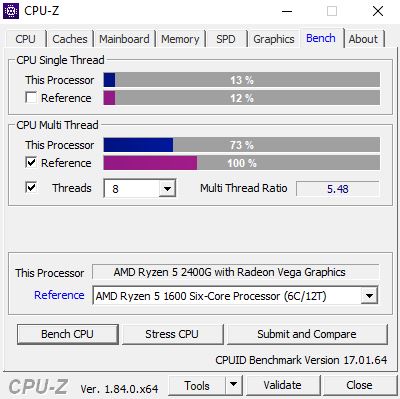
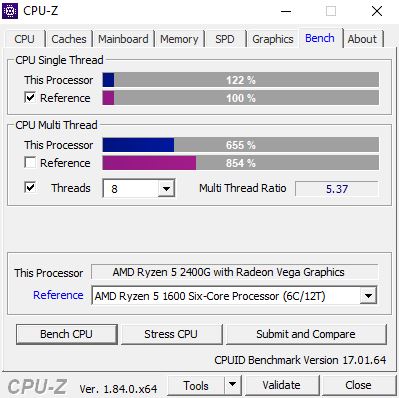
In the CPU Z test it is possible to tangibly verify the performance increase obtained thanks to overclocking: this is a really interesting improvement because it brings the processor to performance comparable to that of the Ryzen 1600, which has 2 more cores.


Even clearer is the performance increase in OC mode, in these two images above. In the first, the score scored on GeekBench by the processor with stock frequencies. In the second, however, the score achieved in OC mode. This is a 10% performance increase in single thread and 17,3% in multicore mode. Not bad considering that you just need to click a button to implement your OC.
Gaming: our battery of games
Rocket League
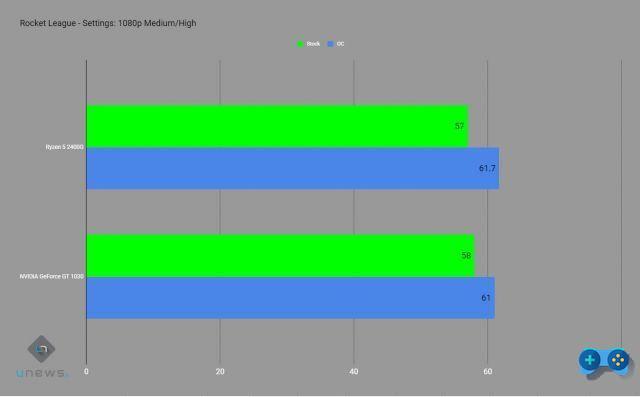
Definitely interesting performance for the first game of our test. Rocket League performs very well with our APU, scoring similar performance to NVIDIA's discrete GT 1030 GPU.
Overwatch
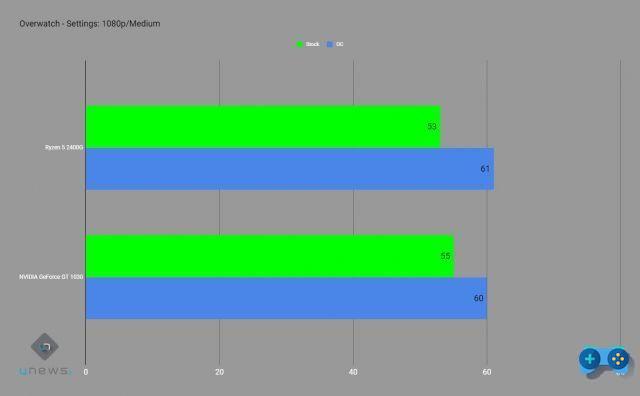
If you're an Overwatch fan, the 2400G might be the right choice for your machine. With a simple overclock to be implemented through the appropriate Ryzen Master platform (by clicking on Game Mode you can access already optimized overclocking configurations) you can obtain respectable performance that will allow you to be fairly competitive even online, where the high frame rate and constant is always preferable.
Grand Theft Auto V
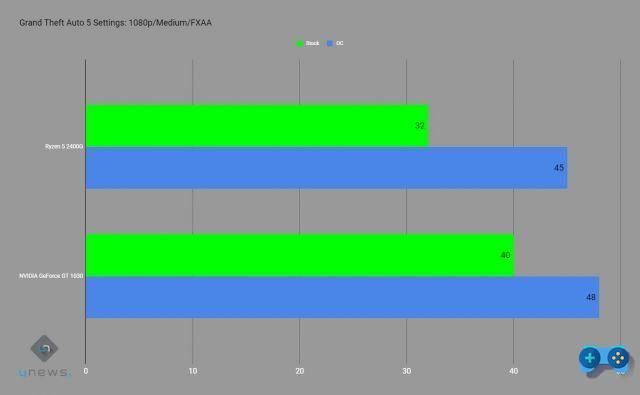
Grand Theft Auto was a surprise. By updating the drivers and overclocking our integrated Vega as much as possible, we were able to get really good performance for a product in this price range. In addition, with details on medium, GTA V is always a great sight.
Civilization VI
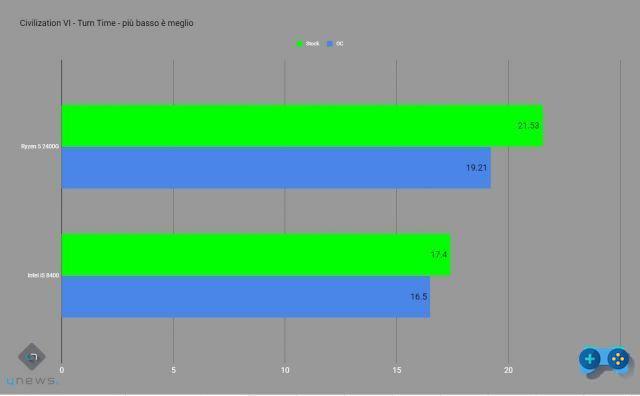
For Civilization VI it makes no sense to talk about frame rates. In fact, the nature of the game does not allow us to evaluate the goodness of our APU with these parameters. We therefore preferred to talk about shift speed, comparing the performance with those obtained with an Intel 8400 Coffee Lake, our AMD's main competitor in this market segment. In this specific test, where the single thread computing capacity matters most, the Intel processor performs much better but we can say that we expected it. The 2400G has in fact performance in single thread lower (like the rest of the Ryzen range) to those of the Intel counterpart, then recovering in multithread; this has definitely penalized our processor which has a lower performance of about 19% compared to the Intel processor, with stock frequencies, and about 14% with overclocked frequencies.
Total War: Warhammer
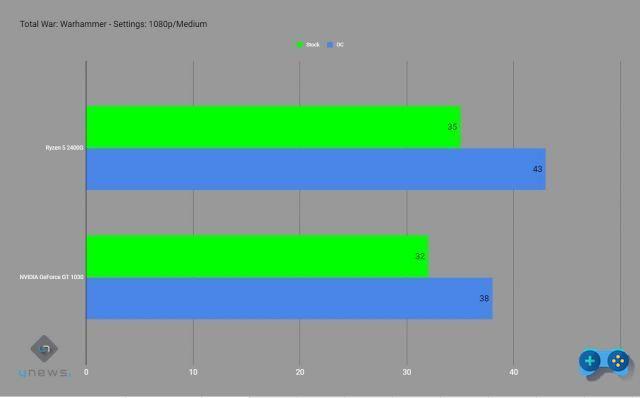
Total War: Warhammer also performs very well with stock frequencies and excellently after the integrated Vega OC. Paradoxically, the performances in this case are even higher than those observed with the GT 1030, a sign of a good optimization for the red team cards.
Rise of the Tomb Raider
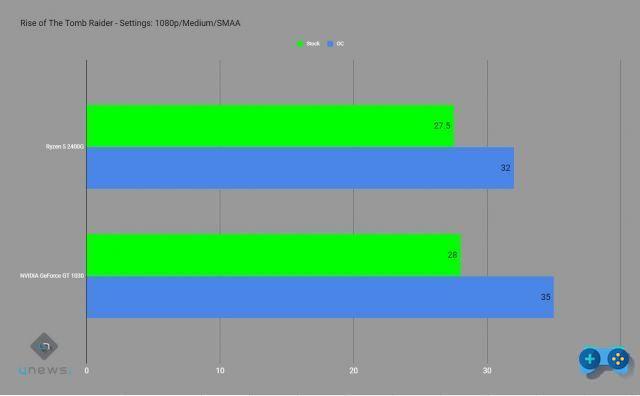
Rise of the Tomb Raider it is the most problematic game observed in our test. The performance becomes acceptable only if you overclock the processor, remaining rather dancers with stock frequency. Lowering the resolution to 900p the situation changes dramatically, bringing the frame rate around 45 fps in OC.
Conclusions and judgment
AMD Ryzen 5 2400G makes possible what until now was not: creating an entry level gaming machine with a price of sub 500 euros and integrated graphics, able to offer decent 1080p gaming with the most common videogames in circulation and performance similar to that of an NVIDIA GT 1030. Of course, some compromises are necessary (Vega 8 seems to have little appreciation for anti-aliasing, so lowering it you can get much better performance), but in general the performance is comparable if you allow us the comparison that it will anger someone, to those of the consoles of the current generation or just slightly lower. If you lower the resolution further to 900p (no, that's not a heresy, considering that most Xbox One games run at that resolution) you can further improve performance by reaching frame rates up to 60fps and medium-high details: a solution that could be useful for those games where a higher frame rate is needed rather than a better resolution. The new family of Ryzen processors with integrated Vega is also useful for making a small one Compact PC for use as a home theater without disdaining some videogames from time to time. As for the processor, however, its performance is comparable to that of Ryzen 5 1400, however, thanks to the good overclocking possibilities if using high frequency memories, it is possible to achieve performance similar to that of a processor Ryzen 5 1600, which has a comparable price but lacks the integrated.
Ryzen 5 2400G (as well as its younger brother Ryzen 3 2200G), moreover, it is the perfect choice for those who intend to build their own gaming machine now, upgrading in the future with a dedicated video card or a more performing processor. Using the same AM4 socket of all the processors of the Ryzen family, the Ryzen platform will guarantee, also for the future, excellent upgrade possibilities and above all immediate access to the wide catalog of motherboards, more or less performing, already available from manufacturers. . So if you are about to build your own gaming machine and don't have much money available, Ryzen 5 could really be the right choice.




